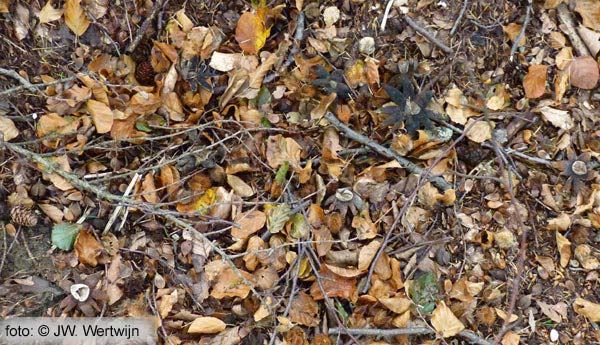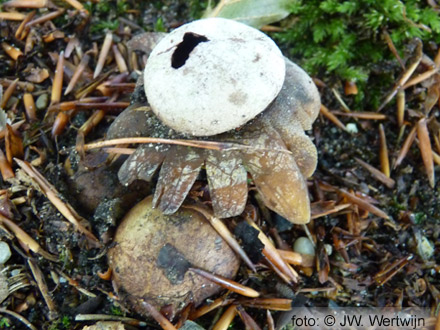Barometer Earthstar - Astraeus hygrometricus
|
|
|
|
|
Photo's: Spanderswoud, October 9 2011
|
|
|
Barometer Earthstar
(Astraeus hygrometicus)
NMV Ga 201010
|
Barometer Earthstar is not a real Earthstar (Geastrum) because there is no columella in the balloon. Geastrum-species always have one and only one columella.
Barometer Earthstar and Leatherstar do not have a columella; Pepper Pot has more than one.
Habitat:
ectomycorrhiza with Common Oak and Beech.
Barometer Earthstar prefers calcareous-poor, acidic soil.
Barometer Earthstar prefers sunny places in deciduous, coniferous and mixed forests, in heathland, along road-sides,
in oak coppice woods and in beech-lanes.
Barometer Earthstar is loyal for decades to its pitch, and often is growing in fairy-rings.
Wood species:
Deciduous wood (beech, Common Oak, larch).
|
|
One of the classic pitches in this area is in "Het Gooi" (the pleistocene area).
For many, many years Barometer Earthstar was found there, in a beech lane on the sunny side of the lane,
and not at the other side.
This behavior changed due to landscape reconstruction work.
An ecological connection was built for heathland animals,
and a lot of beech, White Birch and pine trees had to go.
This lead after a heavy rain to erosion of a slope roadside.
That was repaired with heavy trucks. Which is, after all, not a good idea to save mycelia.
Since then Barometer Earthstars were growing at the shadow side of the beech lane.
In 2012 the next step for the same ecological connection is started, guess where. Right.
But, luckily, in 2013 Barometer Earthstar again has been found a few meters away along the roadside.
|
|
|
|
Photo's: Spanderswoud, October 9 2011 |
|
|
Barometer Earthstars are not mistakable, except as a bulb in the ground:
There is no mouth-zone, the balloon is felty, the star-rays are bursting.
Mature Barometer Earthstars have other field-marks, and are not mistakable:
There is a fissure instead of a mouth-zone,
the balloon-skin is paper-thin and often dinted,
and the star-rays often are hygroscopic curled.
Older Barometer Earthstars are loosing their balloons. In such cases you only can find the star-rays.
No columella, so no scar. The only field-mark is a big circle, almost as broad as the balloon, on the place the balloon was fixed.
That circle is specific field-mark of Barometer Earthstars. Sometimes you can see more.
|
|
Curling star-rays sometimes show the hygroscipic property, but often, when the balloon has gone, the star-rays do not curl anymore.
Mistakability based on hygroscopic property is possible if you do not have an eye for habitats.
Other hygroscopic species are: Weathered Earthstar (Geastrum corollinum)
and the Flowering Earthstar (Geastrum floriforme).
But these two species do not have the big circle of the lost Barometer Earthstar balloon.
|

Mental image, between beech leaves and larch twigs |
|

Barometer Earthstar in Het Gooi, September 11 2010.
|
|
Barometer Earthstar Field-Marks:
- Balloon: no mouth-zone
- Balloon: fissure
- Balloon: surface fresh woolly-felty-fibrous
- Star-rays: top strong crushing, the crushed layer disappears in the end
- Star-rays: bottom often spider-web of black fibers
- Star-rays: structure thick, leaherish, hygroscopic
- Star-rays: number very variable, 5-20.
Hygroscopic means: the star-rays are spreading by moist, and curling by dryness.
When it is dry weather, the star-rays can enclose the balloon almost completely.
Hygroscopic earthstars can do this more than once.
This explains the name "Barometer" (reacts on the weather).
|
Literature:
Chrispijn, R. ed. (1999), Champignons in de Jordaan (De paddenstoelen van Amsterdam), Schuyt en Co, 162-163.
Hansen L. & H. Knudsen (1997), Nordic Macromycetes, Vol. 3, Heterobasidioid, aphyllophoroid and gasteromycetoid basidiomycetes, Kopenhagen, 1997, 444 pp.
Jalink, Leo M (1995) De aardsterren van Nederland en België, Coolia 38 Supplement.
|
Top
|